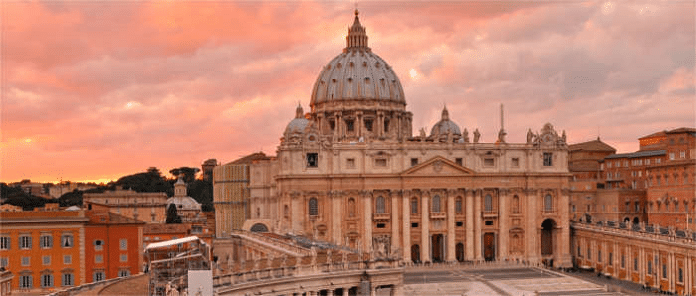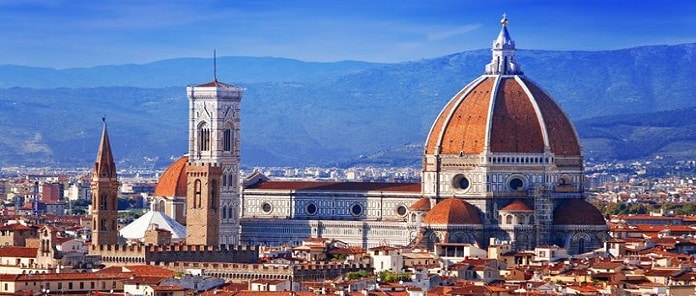Italy is an extraordinary feast of heart-thumping, soul-stirring art, food and landscapes rivalled by few and coveted by millions. A country that’s as varied as the palettes of its great Renaissance artists, awash with color and culture. Lose yourself in the green rolling hills of Tuscany, bathed in the orange glow of the setting sun, and sip a succulent limoncello while taking in the sapphire surf of the sea. Marvel at the fantastical cream-colored figures of the Trevi Fountain, and relax at a neighborhood trattoria with a ruby-red glass of the country’s best Chianti. This isn’t a place where you go to vacation – this is a place where you go to live.
1. Colosseum

Rome’s Colosseum, once home to brutal gladiatorial combat and one of the best preserved monuments and best examples of Ancient Roman architecture in the city is the Colosseum. It took nearly ten years to build one of the world’s largest public venues, is the largest amphitheater ever built in the Roman Empire. One of the new seven wonders of the world, this famous feat of architecture is not to be missed.
Rome’s great gladiatorial arena is the most thrilling of the city’s ancient sights. Inaugurated in AD 80, the 50,000-seat Colosseum, originally known as the Flavian Amphitheatre, was clad in travertine and covered by a huge canvas awning held aloft by 240 masts. Inside, tiered seating encircled the arena, itself built over an underground complex (the hypogeum) where animals were caged and stage sets prepared. Games involved gladiators fighting wild animals or each other.
2. Sassi di Matera

In Matera you’ll spend a lot of time in caves. You’ll sleep in a cave, eat in a cave, drink an aperitivo in a cave, and even view modern sculpture in a cave. The ancient neighbourhoods, known as sassi, are a series of grottoes carved out of limestone, teetering on the edge of a ravine. It’s one of the most unique and spectacular places we’ve visited in Italy or anywhere in the world. Wandering the caves of Sassi di Matera is a must on any trip to Matera. Inhabited by humans as early as the 8th century, some of the caves are now cozy restaurants and hotels.
3. Piazza della Signoria

The Piazza della Signoria has been the center of political life in Florence since the 14th century with the prominent Palazzo Vecchio overlooking the square. It was the scene of great triumphs, such as the return of the Medici in 1530 as well as the Bonfire of the Vanities instigated by Savonarola, who was then himself burned at the stake here in 1498 after he was denounced by the Inquisition as a heretic. A marble circle inscription on the piazza shows the location where he was burned.
The sculptures in Piazza della Signoria bristle with political connotations, many of which are fiercely contradictory. The David (the original is in the Galleria dell’Accademia) by Michelangelo was placed outside the Palazzo Vecchio as a symbol of the Republic’s defiance of the tyrannical Medici.
4. Piazzale Michelangelo

You can reach Piazzale Michelangelo and the Basilica of San Miniato on Monte alle Croci on foot by taking the wonderful spectacular route that architect Giuseppe Poggi created between 1865 and 1871, during the period in which Florence was the capital city of the Kingdom of Italy.
Poggi’s design also included the continuation of the main circular boulevards up into the hills to the south of the city, which he carried out by knocking down what was left of the third circle of city walls of Florence, built between 1284 and 1333. Only a few of the ancient Porte or Gates into the city were saved from demolishment (Porta Romana, Porta al Prato, Porta a San Gallo, Porta a Santa Croce, Porta della Zecca Vecchia and Porta a San Niccolò); Poggi allowed them to remain in the centre of the squares he was creating along the boulevards, where they can still be seen to this day.
5. Pantheon

One of the wonders of the ancient world, this onetime pagan temple, a marvel of architectural harmony and proportion, is the best-preserved ancient building in Rome. It was entirely rebuilt by the emperor Hadrian around AD 120 on the site of an earlier pantheon (from the Greek: pan, or all, and theon, or gods) erected in 27 BC by Augustus’s general Agrippa.
The most striking thing about the Pantheon is not its size, immense though it is, nor even the phenomenal technical difficulties posed by so massive a construction; rather, it’s the remarkable unity of the building. The diameter described by the dome is exactly equal to its height. It’s the use of such simple mathematical balance that gives classical architecture its characteristic sense of proportion and its nobility, and why some call it the world’s only architecturally perfect building. The great opening at the apex of the dome, the oculus, is nearly 30 feet in diameter and was the temple’s only source of light. It was intended to symbolize the “all-seeing eye of heaven.”
6. Basilica di Santa Maria Maggiore

The Basilica of Santa Maria Maggiore is the most important and best preserved of Roman churches dedicated to the Madonna. It rises on top of the Esquiline Hill and is the only remaining example of early Christian architecture, even though it has over time been further embellished.
Work on the current basilica, which was built on top of an earlier church, was embarked on thanks to a wealthy Roman patrician called Giovanni.
According to legend, Giovanni and his wife, who were without child, dedicated a church to the Virgin Mary who had appeared to them in a dream on the night of 4th/ 5th August 352 A.D.
The Madonna had told them that a miracle would show them the location for them to build the church. Pope Liberius also had the same dream and the following day on arriving on the Esquiline Hill, found it had indeed been miraculously covered in snow.. in the heat of August. Liberius then traced an outline of the location of the planned church, the building of which was financed by the married couple.
This then explains why the basilica is also referred to as Our Lady of the Snow and how, every year on 5th August, the miracle of the snow is commemorated with a cascade of white petals descending from the coffered ceiling onto the altar place, an evocative sight really not to be missed.
7. St. Peter’s Basilica

The Papal Basilica of St. Peter in the Vatican, or simply St. Peter’s Basilica, is an Italian Renaissance church in Vatican City, the papal enclave within the city of Rome.
In this city of outstanding churches, none can hold a candle to St Peter’s (Basilica di San Pietro), Italy’s largest, richest and most spectacular basilica. Built atop an earlier 4th-century church, it was completed in 1626 after 120 years’ construction. Its lavish interior contains many spectacular works of art, including three of Italy’s most celebrated masterpieces: Michelangelo’s Pietà, his soaring dome, and Bernini’s 29m-high baldachin over the papal altar.
Expect queues and note that strict dress codes are enforced, so no shorts, miniskirts or bare shoulders.
